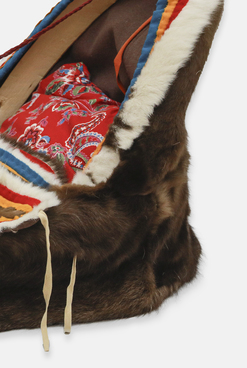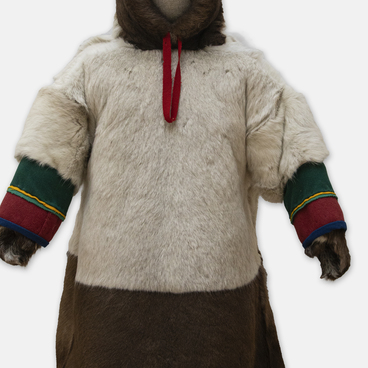A wooden snow knocker was one of the basic accessories in Nenets households. Such knockers stood at the entrance of every home and were used to remove snow from footwear and fur clothing. Moreover, saber-shaped snow knockers were believed to protect the house from strangers and intruders. They had a length of about half a meter and came in two types: for men and for women.
The Nenets Museum of Local Lore houses a women’s wooden snow knocker called “yangats”, which belonged to the family of the reindeer herder Kipriyan Bobrikov. Before migrating, the owner would use it to clear snow from “nyuki” — large canvases of deer hide that served as the walls of the tent. After that, the hides were carefully packed and transported on traditional northern sleds.
Traditionally, the Nenets made all the necessary tools and household items themselves. There were no professional craftsmen in the community, and each family crafted their own belongings. There was a clear division of labor between men and women, which children learned about from an early age. Men worked with wood, bone, and iron, and wove lassos and nets, while women were engaged in hide dressing and sewing.
The Nenets used natural materials to make all the necessary items, treating them with care and following the rules and laws of nature. For example, when harvesting roots, they would only take a small part to avoid killing the entire tree, and birch bark was cut only during specific months when the sap wasn’t flowing. The Nenets knew how to make wood softer and more pliable, how to handle it correctly, and how to preserve it.
The Nenets always had a special relationship with trees and considered them to be sacred. According to ancient beliefs, trees connected the three realms — the Upper, Middle, and Lower Worlds. Wood was used to make poles for tents, sleds, parts of harnesses, khorey poles for steering reindeer, furniture, utensils, cradles, skis, boats, figurines of gods, and amulets from wood.
The Nenets would gather wood in advance when
traveling through the tundra and forests. They mostly used spruce, birch,
larch, and pine. All the items made by the Nenets were well-suited to their
nomadic way of life, which required functionality, minimalism, reliability, and
simplicity. For this reason, both wealthy and poor Nenets families used similar
items in their everyday lives.



